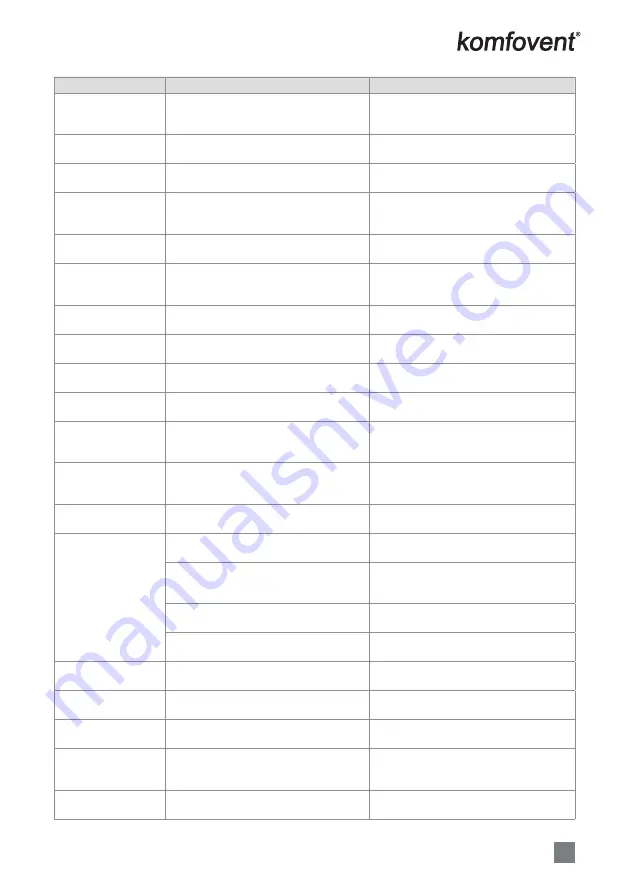
UAB KOMFOVENT we reserve the right to make changes without prior notice
RHP-C5.1_21-01
33
Message
Possible cause
Elimination
Return water tempera-
ture low
Return water temperature of the heater
dropped below the permissible limit.
Check the status and operation of the circula-
tion pump, heating system and mixing valve
actuator.
Internal fire alarm
Fire danger in the ventilation system.
Check the ventilation system. Find the
source of the heat.
External fire alarm
A fire signal has been received from the fire
signalization system of the building.
Delete alarm message and restart the unit
when the fire signal disappears.
External stop
A signal from an external device (switch,
timer, or sensor) has been received.
As soon as the auxiliary device is switched
off, the unit will operate in the previous
mode.
Heat exchanger failure Blocked or not rotating rotor, by-pass
damper failure.
Check the rotor drive, replace the belt or
check the by-pass channel operation.
Heat exchanger icing
Icing may form under a low outdoor tem-
perature and high room humidity.
Check the operation of the rotation heat
exchanger drive or the air bypass damper
of the plate heat exchanger.
Low supply air tem-
perature
The heating equipment fails to operate or
its capacity is insufficient.
Check the heating equipment.
High supply air tem-
perature
The heating equipment is not controllable
(mixing valve or contactor is blocked).
Check the heating equipment.
Electric heater
overheat
The emergency overheating protection of
the electrical heater has actuated.
Protection can be reset only by pressing the
RESET press-button on the heater.
Evaporator air tem-
perature sensor failure
The evaporator air temperature sensor is
not connected or broken.
Check connections of the sensor or replace
the sensor.
Evaporator icing
The evaporator is iced over due to exces-
sively high humidity content in the exhaust
air and low outdoor temperatures.
Check the operation of the evaporator
defrost system.
High pressure on
compressor
Compressor system operated in an over-
load mode as a result of too high tempera-
ture in the condensing unit.
Indentify the cause and eliminate it.
Low pressure on
compressor
Compressor system is leaky or the
amount of refrigerant is insufficient.
Indentify the cause and eliminate it.
Compressor failure
No power supply.
Check supply voltage on the circuit breaker
and/or make sure whether it is on.
Supply voltage mismatches.
Check that the supply voltage is on all three
phases, if necessary, swap the two phase
conductor positions.
Compressor motor failure.
Check the compressor motor and replace it
if necessary.
Compressor drive failure.
Check the operation of the compressor drive
and replace it if necessary.
Supply fan drive
failure
A fault signal has been received from the
supply fan drive.
Check the supply fan drive and its messages.
Supply fan drive
overload
The supply fan drive is overloaded.
Check the condition of the supply fan drive
and its cooling.
Supply fan motor
failure
The supply fan is broken.
Check the supply fan and replace it if neces-
sary.
Supply fan motor
overload
The supply fan is overloaded.
Check the condition of the supply fan and
make sure that the resistance of the ventila-
tion system is not exceeded.
Exhaust fan drive
failure
A fault signal has been received from exhaust
fan drive.
Check the exhaust fan drive and its messages.
























